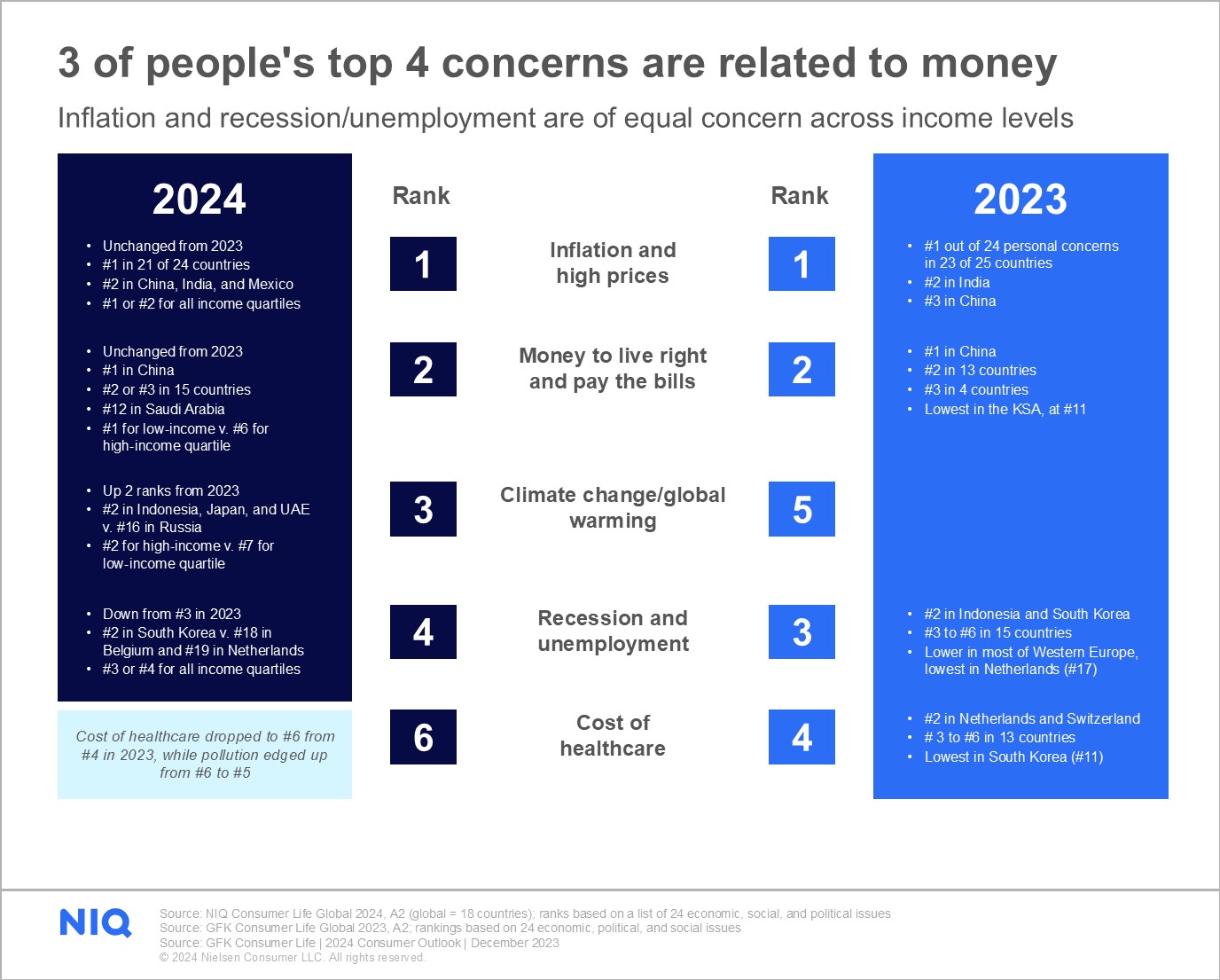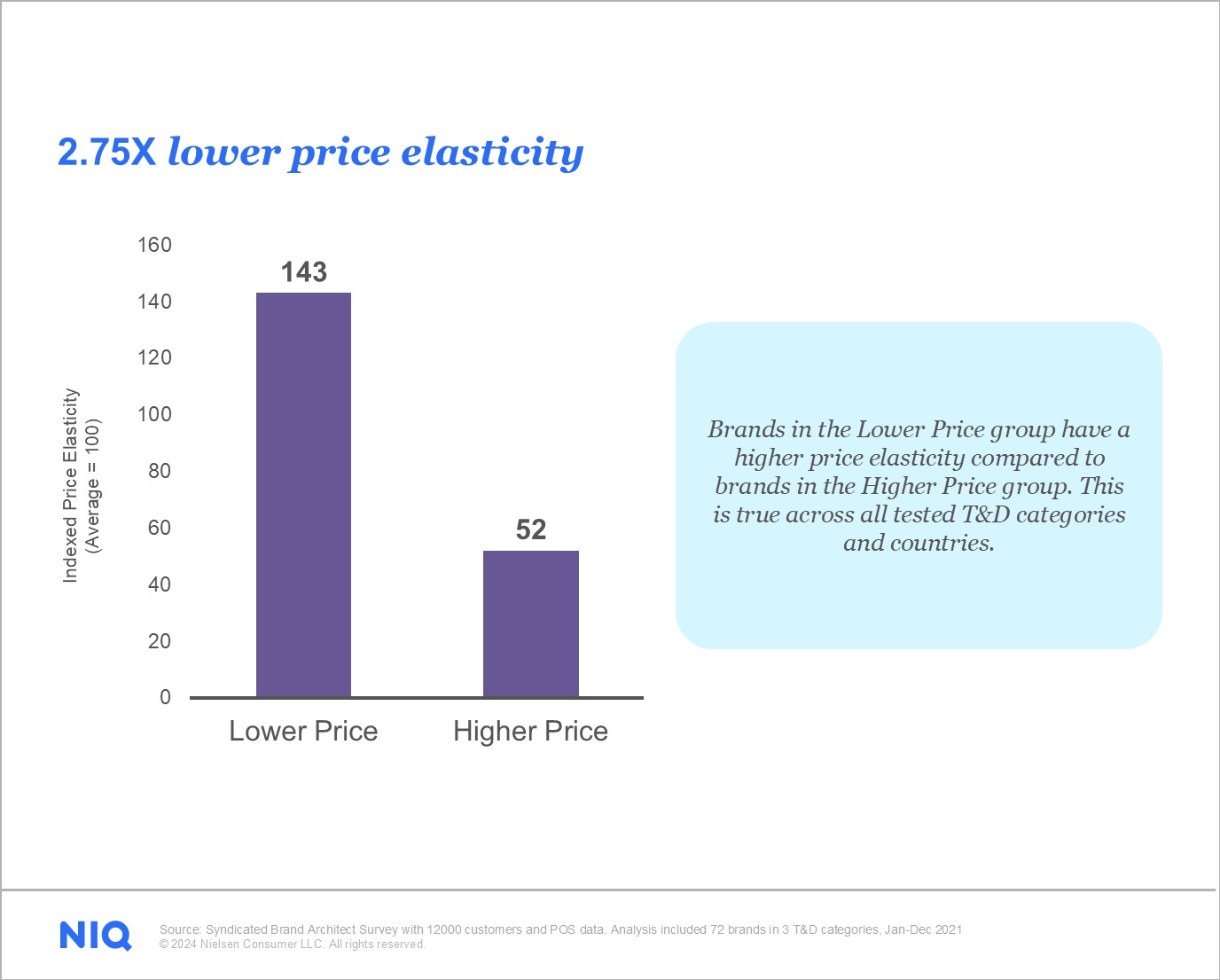The world economy is projected to grow at a modest 3.2% through 20251. While advanced economies show signs of recovery, emerging markets face significant headwinds. Inflation, though easing, continues to impact consumer spending.
In times of economic stagnation, brand building becomes not just a marketing strategy but a crucial business imperative. As shoppers continue to manage their budgets carefully, well-placed brands will be the last ones that people are prepared to trade away from. While competitors may take a short term view and scale back on branding efforts cut costs, it leaves an opportunity for forward-thinking companies to increase their brand presence and visibility. This strategic move can ensure volume resilience and foster deeper customer relationships, which are vital for long-term survival and growth.
Want to learn more about NIQ Brand Architect?
Benefits of Building Brand Resilience During Economic Slowdown:
Expanding Audience Reach: Economic shifts often result in changes in consumer behavior and needs. Brands that proactively engage with a broader audience can capture new market segments that emerge due to down-trading or shifting contextual needs and preferences.
An example of success through audience expansion is e.l.f. Beauty, a company that exceeded $1 billion in annual sales by investing in its brand. e.l.f. has broadened its audience reach by featuring older women like Judge Judy, Jennifer Coolidge, and Billie Jean King in their advertising. As a result, while retaining their core Gen Z market, they have significantly grown their audience among Gen X and older demographics, offering affordable quality cosmetics that appeal to older women looking to stretch their budgets.
Building Price Resilience: Consumers are feeling the impact of cumulative inflation on their wallets with elevated year-on-year inflation compounding (31% increase in unit cost over the last 4 years in the US2) with an inflation-wage gap in most countries. A strong brand can embody a sense of value that transcends price points. By reducing price sensitivity, brands can maintain their appeal even when consumers become more cost-conscious.
Coca-Cola, a company that has reaped the benefits of brand building, considers marketing investment as a “motor to drive the topline and bottom line,” according to CEO James Quincey. He shared this insight with investors after the company achieved an 8% net revenue growth in the third quarter last year, driven by pricing power despite challenging economic conditions.
Price is top of mind for everybody everywhere. The 2024 Consumer Life trends study reveals that out of 24 countries, inflation and high prices was the primary concern in 21 countries and ranked second in the remaining 3. This held true regardless of income level. The study also shows that financial worries are consistent around the world with 3 out of the 4 of people’s top concerns relating to money. So, while today’s global challenges impact consumer habits, brands can take the opportunity to set themselves up for the future.

Strategies for Building Brand Resilience
By remaining visible, relevant and appealing, brands can capitalize on the reduced noise in the marketplace. This involves crafting compelling narratives that resonate with consumers, thereby strengthening mental availability, attachment and image. These pillars must be nurtured to develop a robust brand capable of withstanding market fluctuations. Driving mental availability ensures that the brand is linked to the category and easily comes to mind through category cues and distinctive assets. Attachment and image are carefully crafted through consumer centricity continuously aligning with what people commonly value to find a meaningful brand positioning that is articulated in people’s worlds through your products, experiences and purpose. In essence, it’s about keeping close to consumer needs and priorities in order to imagine new ways to bring people more value. It’s the essence of marketing!
A well-crafted brand strategy directly influences commercial outcomes. Our market measurement data across various categories reveals that brand strength typically contributes to a revenue premium of around 30% of total category value. Strong brands command loyalty, allow for premium pricing, and can lead to increased market share and shareholder value. Investors see brand strength as an indicator of a company’s ability to generate future earnings and sustain growth. The NYT reported a 30% increase in mentions of price elasticity in S&P 500 company calls in 20223. Protecting and enhancing brand strength is paramount, as every action taken by a company can either contribute to or detract from the overall brand strength.
Reducing consumers’ brand price sensitivity is an important lever to ensure sustainable commercial success. Brands that ask a price above the market average have a brand price elasticity that is almost three times lower than other brands,” said Alexandra Chirilov, Head of Marketing Science for Brand and Media at NIQ.

“Pricing power is also known as Brand Premium. It is an outcome of your brand building strategy – and it is what gives Power Brands like Pepsi, Apple, Microsoft, Starbucks and BMW their advantage despite the recent economic crisis. The last decade of investment into these brands has paid off, with consumers willing to pay more for these products even when disposable incomes are squeezed.” Even if you are not a power brand with years of brand building investment behind you, pricing power might mean that your brand will withstand the temptation to discount, pricing will be maintained, and revenue will be preserved.
Galvanize the Business Behind the Brand
To get the entire organization behind the brand mission, it is essential to demonstrate the link between brand strength and business performance. A robust and innovative brand measurement tool can quantify this connection providing tangible evidence of the brand’s contribution to commercial success. Such insights can be instrumental in securing buy-in from key stakeholders, including the CFO and executive team.
It is equally important to ensure that marketing efforts are aligned with brand objectives to ensure consistency and coherence across all touchpoints. Internal silos should be bridged to present a unified brand experience to consumers. Consistent repetition through different avenues within the marketing mix ensures flawless execution of brand and marketing strategy. Marketing should be held accountable for its impact on brand strength, ensuring that all initiatives serve to bolster rather than dilute the brand’s essence. When the whole business focusses on a single north star, brand strength, all the pieces will come together harmoniously.
Invest in Brand for an Upside
When a stagnant economic outlook seems bleak, invest in long-term growth. Focus on creating a brand that more people choose, love and are willing to pay a premium for, by investing in the three pillars of brand strength. This will enable audience expansion and price resilience, allowing you to emerge from economic challenges with a stronger, more resilient brand, a more profitable company and a prosperous future.
Remember, while the economic landscape may shift, the power of a strong brand remains constant.

Ready to build an irresistible brand and drive sustainable growth?
Download our FREE eBook today!
Sources:
1 World Economic Outlook. International Monetary Fund. April 2024
2 Consumer Outlook, NIQ, 2024
3 CEOs Are Obsessed With ‘Elasticity’ as Inflation Soars. Here’s Why. The New York Times. August 2022
4 How e.l.f built a billion dollar brand. Uncensored CMO. 26 June 2024.
5 Coca-Cola CEO: Marketing acts as a ‘motor’ to drive financial results. (Marketingweek.com. 24 October 2023.)
